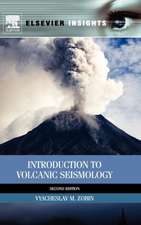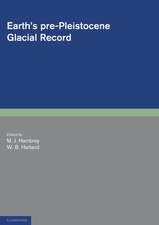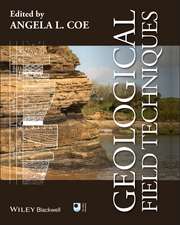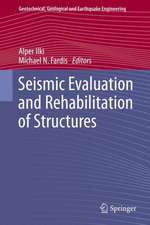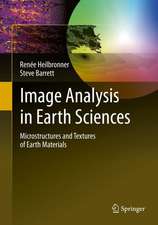Geotectonic Evolution of China
Autor Jishun (Jen Chi-shun) Ren Editat de Qifang Li Traducere de Minxi Jiang Jiqing (T.K. Huang) Huang Traducere de Niansheng Xu Autor Chunfa Jiang Traducere de Zhenbi Fei Autor Zhengkun Zhang Traducere de Ting Wang Autor Deyu Qin Traducere de Mingquan Liuen Limba Engleză Paperback – 12 feb 2012
Preț: 384.70 lei
Nou
Puncte Express: 577
Preț estimativ în valută:
73.61€ • 77.05$ • 61.27£
73.61€ • 77.05$ • 61.27£
Carte tipărită la comandă
Livrare economică 31 martie-14 aprilie
Preluare comenzi: 021 569.72.76
Specificații
ISBN-13: 9783642648748
ISBN-10: 3642648746
Pagini: 236
Ilustrații: X, 218 p.
Dimensiuni: 155 x 235 x 12 mm
Greutate: 0.34 kg
Ediția:Softcover reprint of the original 1st ed. 1987
Editura: Springer Berlin, Heidelberg
Colecția Springer
Locul publicării:Berlin, Heidelberg, Germany
ISBN-10: 3642648746
Pagini: 236
Ilustrații: X, 218 p.
Dimensiuni: 155 x 235 x 12 mm
Greutate: 0.34 kg
Ediția:Softcover reprint of the original 1st ed. 1987
Editura: Springer Berlin, Heidelberg
Colecția Springer
Locul publicării:Berlin, Heidelberg, Germany
Public țintă
ResearchDescriere
Anyone studying the geology and tectonics of China and who is not able to read Chinese will need to have a copy of this book: Ceotectonic Evolution of China and a companion copy of the Tectonic Map of China, scale 1:4000,000. Professor Huang Jiqing and his collaborators from the Institute of Geology, Chinese Academy of Geological Sciences have provided the English-speaking earth scientists with an extremely valuable tool that can be used towards understanding the geo b;;y of China. The introductory chapter is necessary to read prior to effective use of the material discussed in other chapters as it clearly presents the philosophy of this school of tectonics. The collaborators of the book acknowledge the important changes have been brough about by the plate tectonics theory but do not fully incorporate these ideas into their discussion. The book and map are testimony to the tremendous amount of geologic work accomplished by Chinese geologists in the past fourty years. As our Chinese collea gues begin to publish more English summaries such as this, it will become apparent to the rest of the world the vast amount of geologic mapping along with supportive stratigraphy and geophysics that has already been accomplished. Nearly all major non Chinese tracts on tectonic synthesis of the world treat China in only a cursory fashio)1 because so little is known of the area. With this text and map, future world tectonic synthesis can no longer afford to leave China out of the picture.
Cuprins
I. On the Problem of Methods and Theories.- I.1 On the Method of Historical Analysis.- I.2 On Some Theoretical Problems of Geotectonics.- I.2.1 Continents, Oceans and Their Contact Relationship.- I.2.2 Mobile Belts, Stable Regions and Their Transformation.- I.2.3 Rift Valleys and Uplifted Fold Belts.- I.2.4 Tectonic Movements.- I.2.5 Monocyclicity and Polycyclicity.- I.2.6 Tectonic Transition and Tectonic Migration.- I.2.7 Deep Fractures.- I.2.8 On the Problem of Tectonic Stress Fields.- II. Subdivision of the Tectonic Cycles of China.- II.1 The Fuping Cycle.- II.2 The Wutai Cycle.- II.3 The Zhongtiao Cycle.- II.4 The Wuling Cycle.- II. 5 The Yangtze Cycle.- II. 6 The Xingkai Cycle.- II.7 The Caledonian Cycle.- II. 8 The Variscan Cycle.- II. 9 The Alpine Cycle.- II.9.1 The Indosinian Subcycle.- II.9.2 The Yanshanian Subcycle.- II.9.3 The Himalayan Subcycle.- III. Brief Description of the Main Tectonic Units of China.- III.1 System of Nomenclature for Tectonic Units.- III.2 The Sino-Korean Para platform.- III.3 The Yangtze Paraplatform.- III.4 The Tarim Platform.- III.5 The South China Sea Platform.- III.6 The Sayan-Ergun Géosynclinal Fold Region.- III.7 The Tianshan-Hinggan Géosynclinal Fold Region.- III.7.1 The Altay Fold System.- III.7.2 The Junggar Fold System.- III.7.3 The Tianshan Fold System.- III.7.4 The Inner Mongolian-Greater Hinggan Fold System.- III.7.5 The Jilin-Heilongjiang Fold System.- III.8 The Kunlun-Qinling Géosynclinal Fold Region.- III.8.1 The Qilian Fold System.- III.8.2 The Qinling Fold System.- III.8.3 The Eastern Kunlun Fold System.- III.8.4 The Western Kunlun Fold System.- III.9 The Yunnan-Tibet Géosynclinal Fold Region.- III.9.1 The Songpan-Garze Fold System.- III.9.2 The Sanjiang (Three-River) Fold System.- III.9.3 The Karakorum-Tanggula Fold System.- III.9.4 The Gangdisê-Nyainqêntanglha Fold System.- III.10 The Himalayan Géosynclinal Fold Region.- III.11 The Marginal-Pacific Géosynclinal Fold Region.- III.11.1 The Upper Heilongjiang Miogeosynclinal Fold Belt.- III.11.2 The Nadanhada Eugeosynclinal Fold Belt.- III.11.3 The Yanbian Fold System.- III.11.4 The South China Fold System.- III.11.5 The Southeastern Coastal Fold System.- III.12 The Géosynclinal Fold Region of the Western Pacific Island Arcs.- III.13 The Epicontinental Basins and Marginal Sea Basins in Eastern China.- III.13.1 The East China Sea.- III.13.2 The Bohai Sea and the Huanghai Sea.- III.13.3 The South China Sea.- IV. The Geosynclines of China and Their Main Characteristics.- IV.1 The Subdivision of the Geosynclines of China and Their Development.- IV.1.1 The Géosynclinal Regions of the Pal-Asian Tectonic Domain.- IV.1.2 The Géosynclinal Regions of the Tethys-Himalayan Tectonic Domain.- IV.1.3 The Géosynclinal Regions of the Marginal Pacific Tectonic Domain.- IV.2 The Classification of the Geosynclines of China and the Sequence of Their Sedimentary Formations.- IV. 3 The Formation and Transformation of the Geosynclines of China.- IV.3.1 The Formation of the Geosynclines of China.- IV.3.2 The Transformation of the Geosynclines of China.- IV.4 The Contact Relationship Between the Geosynclines and Platforms of China.- IV.5 The Poly cyclic Development of the Geosynclines of China.- IV.5.1 On Tectonic Migration.- IV.5.2 On the Differentiation of Geosynclines.- IV.5.3 On the Model of Evolution of Geosynclines A Point Line Plane Model.- V. Deep Fractures and Deep-Seated Structures in China.- V.1 The Tectonic Framework Shown by Deep Fractures in China.- V.1.1 The Pal-Asian Fracture Mega-system.- V.1.2 The Marginal Pacific Fracture Mega-system.- V.1.3 The Tethys-Himalayan Fracture Mega-system.- V.1.4 An Interim Summary.- V.2 Brief Descriptions of the Main Deep Fractures in China.- V.2.4.1 Translithospheric Fracture Zone.- V.2.2 The Most Important Shear Deep Fractures.- V.2.3 Crustal Fractures.- V.3 The Relationship Between Tectonic Framework of the Fractures and Deep-Seated Structures of China.- VI. The Geotectonic Evolution of China.- VI.1 The Archean and Eo-Algonkian Megacycle (Archean-Early Proterozoic) Gradual Formation of the Sino-Korean Para platform.- VI.1.1 The Fuping Cycle and Older.- VI.1.2 The Wutai Cycle.- VI.1.3 The Zhongtiao Cycle.- VI.2 The Neo-Algonkian Megacycle (Late Proterozoic) the Formation of the Chinese Protoplatform.- VI.2.1 The Two Different Types of Sedimentation in the Late Proterozoic.- VI.2.2 The Yangtze Orogenic Cycle and the Formation of the Chinese Protoplatform.- VI. 3 The Establishment of the Xingkai Cycle and the Disintegration of the Chinese Protoplatform.- VI.3.1 The Establishment of the Xingkai Cycle.- VI.3.2 The Disintegration of the Chinese Protoplatform.- VI.4 The Early Neogaic Megacycle (Paleozoic) — the Formation of Pal-Asia.- VI.5 The Late Neogaic Megacycle (Mesozoic-Cenozoic) — the Formation and Development of the Marginal-Pacific Tectonic Domain and the Tethys-Himalayan Tectonic Domain.- VI.5.1 The Development of the Marginal-Pacific Tectonic Domain.- VI.5.2 The Development of the Tethys-Himalayan Tectonic Domain.- VI.6 The Himalayan Movement and Its Significance in the Tectonic Development of China.- VI.6.1 Meaning and Subdivision.- VI.6.2 The Tectonic Characteristics of the Himalayan Subcycle in Western China.- VI.6.3 The Tectonic Characteristics of the Himalayan Subcycle in Eastern China.- VI.6.4 The Geotectonic Evolution of China and Its Neighbouring Regions Since the Himalayan Subcycle.- References.- Explanations of Plates.


